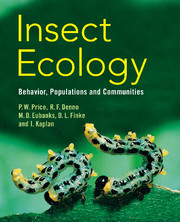Book contents
- Frontmatter
- Contents
- Preface
- Acknowledgments
- Part I Introduction
- Part II Behavioral ecology
- 2 Behavior, mating systems and sexual selection
- 3 Social insects: the evolution and ecological consequences of sociality
- Part III Species interactions
- Part IV Population ecology
- Part V Food webs and communities
- Part VI Broad patterns in nature
- Glossary
- References
- Author Index
- Taxonomic Index
- Subject Index
- Plate section
- References
3 - Social insects: the evolution and ecological consequences of sociality
from Part II - Behavioral ecology
Published online by Cambridge University Press: 05 June 2012
- Frontmatter
- Contents
- Preface
- Acknowledgments
- Part I Introduction
- Part II Behavioral ecology
- 2 Behavior, mating systems and sexual selection
- 3 Social insects: the evolution and ecological consequences of sociality
- Part III Species interactions
- Part IV Population ecology
- Part V Food webs and communities
- Part VI Broad patterns in nature
- Glossary
- References
- Author Index
- Taxonomic Index
- Subject Index
- Plate section
- References
Summary
Social insects are major components of most ecosystems and are key players in communities. We will see in this chapter that their biomass is impressive, their activities as ecosystem engineers – making nests, trails and moving soil – are massive, and their impacts on other community members are widespread.
Social insects stimulate immense fascination among their human observers because of their ubiquity, their diurnal activity and their complex social structure involving many sophisticated behavioral interactions. They also pose the problem of how such societies evolved: under which ecological conditions would selection favor the banding together of related individuals into dense populations distinct from most species whose individuals disperse widely from others? The interplay of life-history evolution, behavior, ecology and phylogeny in the emergence of social insects offers an excellent example of how these biological processes are inevitably meshed together and how we need to address them with an integrated-biology approach.
- Type
- Chapter
- Information
- Insect EcologyBehavior, Populations and Communities, pp. 72 - 96Publisher: Cambridge University PressPrint publication year: 2011



